Table of Contents
Humanoid robots aren’t cheap, but they’re a game-changer. We’re talking $20k-$150k now, with prices nosediving to $13k by 2035. Sure, that sounds steep, but these aren’t your grandpa’s clunky machines. They’re productivity powerhouses that slash labor costs by 75%, revolutionize healthcare, and transform industries. Think of them as workforce superheroes—expensive upfront, but they’ll make money while you sleep. Curious about how they’ll reshape our world? Stick around.
The Shocking Price Tag: Understanding Humanoid Robot Costs
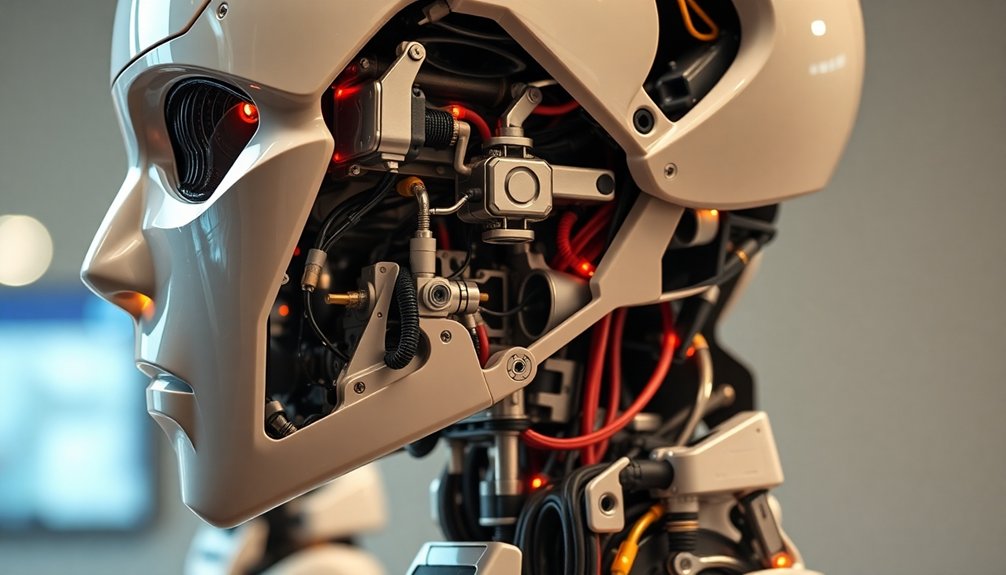
Ready to have your mind blown? Humanoid robots aren’t just sci-fi fantasies anymore—they’re real, and their price tags are dropping faster than you’d believe. Industrial robotics trends suggest a massive transformation in pricing and accessibility is imminent.
Right now, these mechanical marvels cost around $200,000, which sounds insane. But here’s the kicker: by 2035, we’re looking at prices between $13,000 and $17,000. That’s cheaper than some luxury cars!
Robots are dropping in price faster than you can say futuristic: from $200K to under $20K in just over a decade!
The Engine AI SE01 is already breaking ground, offering mind-blowing features like 32 degrees of freedom and advanced AI for just $20,000 to $27,000. Robotic component innovations are driving down manufacturing costs and making these technological wonders more accessible than ever before.
As manufacturing gets smarter and components become more efficient, these robots are transforming from exotic tech toys to potential household helpers. Global market projections indicate that by 2050, nearly 1 billion humanoids will revolutionize industrial and commercial landscapes.
Who would’ve thought robots could become more affordable than your annual salary?
Breaking Down the Investment: Research and Development Expenses
We’ve been tracking the wild world of humanoid robot development, and let’s be real – these mechanical humans aren’t cheap to dream up.
Engineering a robot that can walk, talk, and maybe not accidentally destroy humanity requires mind-boggling investments in prototype development and cutting-edge technology research. These investments draw inspiration from historical robotic innovations pioneered by visionaries like Leonardo da Vinci, who first conceptualized mechanical human-like machines.
Think of it like building a super-intelligent, potentially world-changing iPhone that can also lift heavy things and potentially replace human workers – except this “phone” costs more than most people’s annual salary.
Currently, manufacturers are seeing a dramatic cost reduction from $50,000-$250,000 to $30,000-$150,000 per humanoid robot, reflecting significant advances in production efficiency and technological innovation.
Interestingly, the rapid advancement in neural network control has enabled robots to mimic human brain functions, transforming them from mere mechanical constructs to increasingly sophisticated autonomous systems.
Engineering Complexity Costs
Because building a humanoid robot isn’t like assembling a fancy LEGO set, the engineering complexity costs will make your wallet weep.
We’re talking semiconductor price tags that’ll make your credit card spontaneously combust. High-precision components, advanced AI software, and cutting-edge materials don’t come cheap. Each robotic brain requires insanely complex semiconductors and software that fundamentally cost more than some people’s annual salary. Robotic manufacturing costs have dramatically dropped from $50k-$250k to $30k-$150k per unit, representing a significant technological and economic breakthrough.
Manufacturing these mechanical marvels demands specialized engineers who aren’t working for pizza and goodwill. From intricate gear systems to breakthrough AI algorithms, every single component represents a miniature technological Mount Everest of research and development. The Asia Pacific market is leading the charge in humanoid robot innovation, driving down costs through massive technological investment.
And let’s be real: innovating at this level means constantly pushing boundaries, which translates directly into eye-watering expenses.
But hey, future-changing technology was never going to be a bargain-bin special.
Prototype Development Expenses
Developing a humanoid robot prototype isn’t just throwing cash into a technological bonfire—it’s a meticulously calculated financial journey through innovation’s most expensive landscape.
We’re talking serious coin here: high-end sensors that cost more than most people’s monthly rent, materials that require a small fortune, and design complexity that makes rocket science look like child’s play. By 2030, BOM cost reduction could plummet by over 50%, making these technological marvels more economically feasible.
Every component adds zeroes to our budget—advanced actuators, precision processing units, and intricate mechanical systems. Research and development expenses can escalate rapidly, with prototypes potentially costing over $500,000 in advanced technological fields.
Testing isn’t just a checkbox; it’s a grueling marathon of iterations where each prototype costs more than most cars.
We’re not just building robots; we’re engineering the future, one expensive experiment at a time.
And let’s be real: those cutting-edge prototypes? They’re worth every penny.
Technology Research Investments
As robotics transforms from sci-fi fantasy to industrial reality, technology research investments are becoming the rocket fuel propelling humanoid machines from lab curiosities to marketplace game-changers.
We’re watching billions pour into cutting-edge research, with governments and private companies betting big on robots that could revolutionize everything from manufacturing to healthcare. Japan, a global leader in industrial robotics, is investing nearly $1 billion in healthcare robot development to drive technological innovation.
The numbers are wild: $1 billion budgets, potential $5 trillion markets by 2050, and projected shipments of over 250,000 robots by 2030. Home robotics market is projected to grow exponentially, with significant innovations driving consumer adoption.
What’s driving this? Plummeting component costs, smarter AI, and killer collaborations between tech wizards.
Think of it like assembling a superhero team: brain experts, body engineers, and integration gurus working together to create machines that might just change how we work, live, and imagine possibility.
Market growth projections suggest the humanoid robot industry is poised to expand from USD 2.92 billion in 2025 to a staggering USD 15.26 billion by 2030, signaling massive potential for technological innovation.
Material Matters: Why Robot Components Drive Up Prices
When you peek under the hood of a humanoid robot, you’ll quickly realize that materials aren’t just some boring engineering detail—they’re the difference between a bargain-bin toy and a machine that could genuinely transform how we work.
Metal or plastic? It’s not just a choice—it’s a financial rollercoaster. High-grade alloys might cost a fortune, but they’re the difference between a robot that looks impressive and one that actually survives real-world challenges. Lightweight materials like aluminum and carbon fiber provide crucial strength and agility for advanced robotic designs.
Plastic saves cash but crumbles under pressure. Custom-machined parts for robot joints? They’re basically precision jewelry for machines. Based on current market projections, robot manufacturing costs are expected to dramatically decrease with mass production, potentially making advanced robotic materials more accessible in the coming decades.
A simple plastic robot might set you back $10k, while a metal marvel can easily rocket past $100k. The brutal truth? Quality costs—but for robots that can actually do something meaningful, it’s worth every penny.
Performance vs. Price: Comparing Affordable and Advanced Models
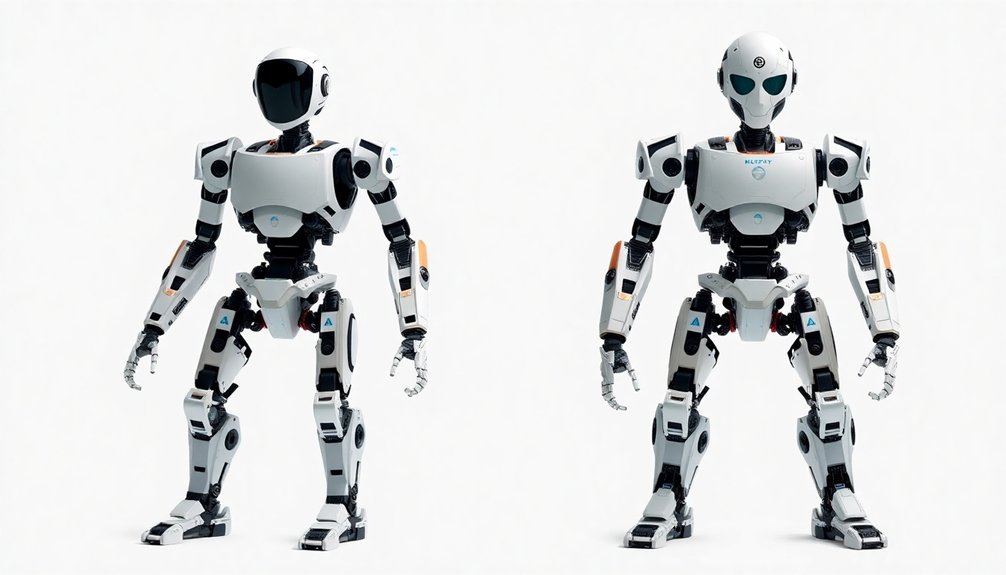
We’ve seen humanoid robots transform from sci-fi fantasies to real-world price tags, ranging from a used car’s cost to a small mansion’s investment.
When we look at the robot spectrum, it’s clear that performance isn’t just about how many zeros are on the price tag – the Unitree G1 at $16,000 can handle basic tasks, while the XPeng Iron at $150,000 brings industrial-grade sophistication that makes your average warehouse worker look like a slow-motion replay.
What matters isn’t just the price, but the value: can these mechanical marvels actually make our lives easier, or are they just expensive toys that look cool in a showroom?
Price-Performance Robot Spectrum
If you’ve ever wondered whether robots are just fancy toys or legitimate game-changers, the price-performance spectrum of humanoid robots will blow your mind.
We’re talking a wild ride from $10,000 domestic helpers to $150,000 industrial powerhouses. Want flexibility? Engine AI’s SE01 delivers 32 degrees of freedom and jaw-dropping joint torque for a cool $20,000.
Craving industrial muscle? XPeng’s Iron packs 60 articulating joints and proprietary AI chips, perfect for warehouses that demand precision.
The price difference isn’t just numbers—it’s raw capability. Budget models might walk and wave, but high-end robots can practically think.
And here’s the kicker: as mass production ramps up, these mechanical marvels will get cheaper. Today’s $150,000 robot is tomorrow’s affordable assistant.
Value Beyond Cost
Three critical price points are reshaping how we think about humanoid robots: budget, mid-range, and industrial-grade. We’re witnessing a robot revolution where performance isn’t just about fancy tech, but real-world value.
| Category | Price Range | Key Features |
|---|---|---|
| Budget | $10k | Basic tasks, home assistance |
| Mid-Range | $12k-$30k | Complex movement, versatility |
| Industrial | $90k-$150k | Advanced AI, precision tasks |
Imagine robots that don’t just drain your wallet but actually improve your life. Engine AI’s PM01 proves you don’t need to sell a kidney for cutting-edge tech. At $12,000, it delivers 23 axes of movement that’ll make your current gadgets look like ancient relics. Sure, XPeng’s Iron costs a pretty penny at $150,000, but it’s basically a Swiss Army knife with a brain. The future isn’t about how much a robot costs — it’s about how much value it brings.
Long-Term Value: Calculating Return on Robotic Investment
When considering the long-term value of humanoid robots, investors must look beyond the sticker shock and dive deep into the nitty-gritty of return on investment (ROI).
We’re talking serious money math here. By multiplying initial robot costs by three and tracking annual cash inflows, companies can see real savings emerge.
Sure, you’re looking at a hefty upfront investment, but robots work 24/7 without coffee breaks or sick days. They boost productivity, maintain laser-focused quality, and slash labor costs to about 25% of traditional expenses.
Robotic workers: unstoppable productivity machines slashing labor costs and working round the clock with machine-like precision.
The key? Smart maintenance and strategic integration. Unplanned downtime is the silent killer of ROI, so choose your robot supplier like you’d choose a life partner—with serious research and zero compromise.
Bottom line: Robots aren’t just expensive toys; they’re your productivity secret weapon.
Industry Applications That Justify the Expense
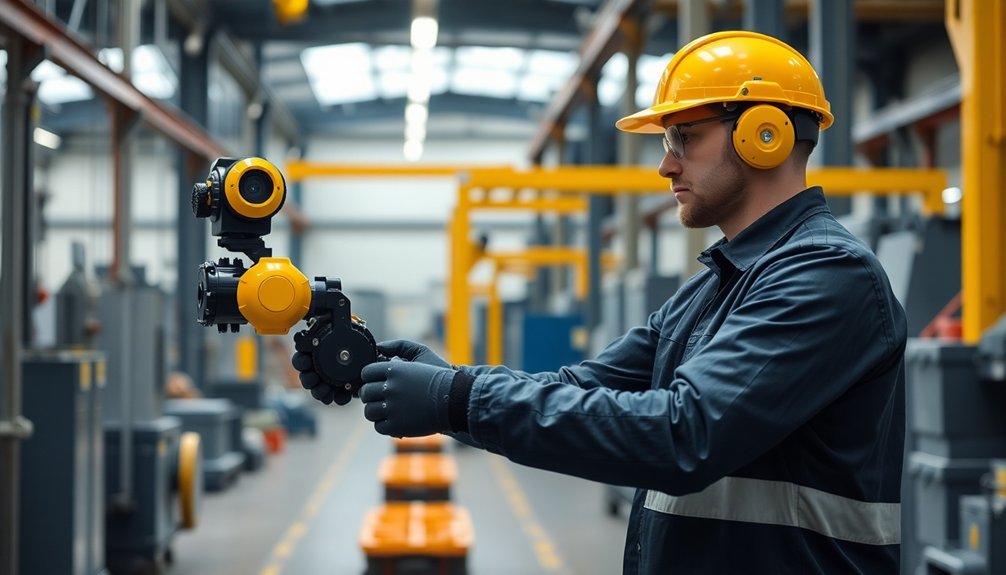
We’re looking at a robotic revolution that’s not just sci-fi fantasy, but a pragmatic economic shift across industries.
Humanoid robots are proving they’re more than expensive toys by tackling complex tasks in healthcare, manufacturing, and disaster response—transforming how we think about workforce capabilities.
Robotic Workforce Transformation
Because the future of work is rapidly evolving, humanoid robots are transforming industries in ways we never expected.
Imagine factories where precision meets flexibility, and healthcare settings where robots handle mundane tasks while humans focus on complex care.
We’re seeing a massive shift: robots aren’t just replacing workers, they’re creating entirely new job ecosystems. By 2050, these mechanical colleagues could generate a $5 trillion market – bigger than today’s entire auto industry.
From manufacturing to medical care, humanoid robots are becoming essential teammates. They’re not just machines; they’re problem-solving partners who can handle repetitive tasks with superhuman consistency.
And let’s be real: who wouldn’t want a tireless, highly efficient robot colleague who doesn’t complain about Monday mornings?
Cost-Effective Technical Solutions
Although humanoid robots might sound like something out of a sci-fi movie, they’re quickly becoming cost-effective solutions that make serious business sense. We’re not talking about breaking the bank—we’re talking about strategic investments that transform industries.
| Application | Cost Savings |
|---|---|
| Manufacturing | 40-60% Labor Reduction |
| Healthcare | 25-35% Operational Efficiency |
| Supply Chain | 30-50% Process Optimization |
| Education | 20-40% Interactive Learning |
Imagine robots that work 24/7 without coffee breaks, minimize human error, and tackle dangerous tasks. They’re precision machines that don’t just replace workers—they elevate entire operational ecosystems. From assembly lines to hospital wards, these mechanical marvels aren’t expenses; they’re game-changing investments that deliver measurable ROI. Who wouldn’t want a tireless teammate that never complains and consistently outperforms human limitations?
Technology That Transforms: Advanced Features Driving Costs
Humanoid robots aren’t just fancy toys anymore—they’re becoming mind-blowingly complex machines that push the boundaries of what technology can do.
These aren’t your grandpa’s clunky prototypes; they’re sophisticated systems packed with innovations that justify their hefty price tags.
These cutting-edge robots redefine technological innovation, transforming yesterday’s mechanical dreams into today’s intelligent reality.
We’re talking about robots with:
- Advanced AI that learns and adapts like a digital chameleon, recognizing faces and understanding human speech
- Sensor networks so precise they can detect objects and mimic human movements with uncanny accuracy
- Electric systems and servo joints that give machines strength, flexibility, and near-human agility
Want to know why these robots cost a small fortune?
It’s because they’re fundamentally walking, talking technological marvels that blur the line between machine and intelligent companion.
And trust us, they’re just getting started.
Market Dynamics: Supply, Demand, and Pricing Trends
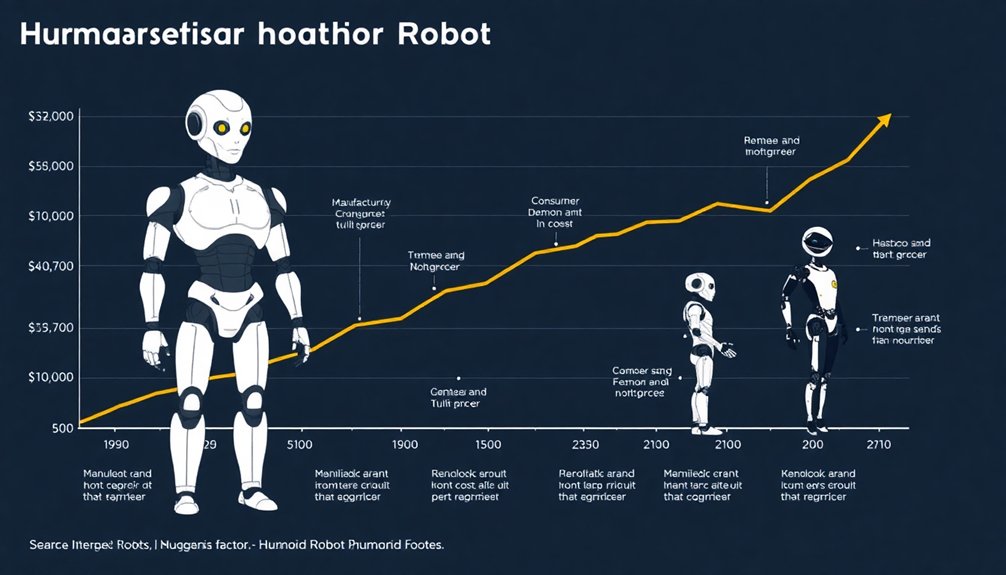
When the robots come knocking, they’ll bring a price tag that’ll make your wallet weep.
We’re looking at a market that’ll explode from $4.32B to $69.74B by 2032—and not quietly.
Industrial-grade humanoids like XPeng’s Iron will cost up to $150,000, while domestic helpers start at a more modest $10,000.
But here’s the kicker: prices will nosedive as technology matures. Think of it like smartphones—once clunky and expensive, now ubiquitous and cheap.
The real game-changer? Massive demand from healthcare, elderly care, and service industries.
By 2050, we’re talking a $5T market with over 1B robots in action.
Sure, right now robots are lab curiosities. But give it a decade, and they’ll be as common as your smartphone—just way more expensive.
Cost Reduction Strategies in Robotic Manufacturing
Since manufacturing costs can make or break a robotics company, smart strategies for reducing expenses have become the holy grail of industrial automation.
We’re talking serious cost-cutting magic that transforms robotic production from budget-busting to profit-generating.
Our top strategies for slashing expenses include:
🤖 Robotics cost-cutting: cobots, lean principles, and energy efficiency—turning manufacturing into a profit powerhouse. 💡
- Implementing collaborative robots (cobots) that work alongside humans, reducing labor costs by up to 17.71%
- Embracing lean manufacturing principles to eliminate waste and optimize every single production step
- Investing in energy-efficient equipment that cuts electricity consumption and boosts overall efficiency
The brutal truth? Robotics isn’t just about cool tech—it’s about ruthless optimization.
By strategically deploying automation, we’re not just saving money; we’re revolutionizing how manufacturing works.
Who wouldn’t want smarter, faster, cheaper production that makes bean counters and engineers equally happy?
Future Forecasts: Price Predictions and Technological Evolution
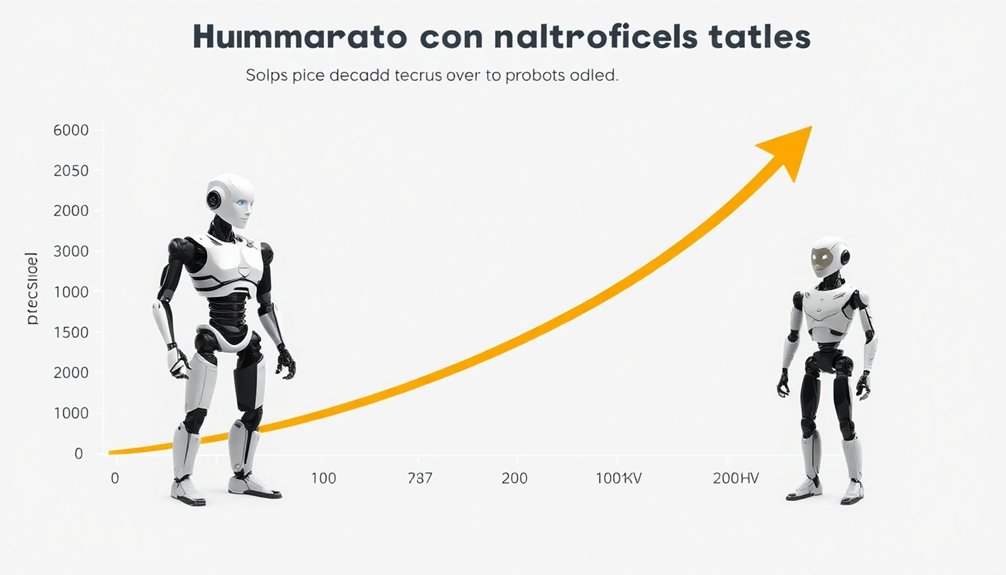
As artificial intelligence continues its relentless march forward, the future of humanoid robots looks less like science fiction and more like an impending reality check.
We’re watching prices plummet faster than a skydiver without a parachute—from $250,000 to potentially under $30,000 per unit. Why? Because AI and machine learning are turning these mechanical humans into seriously smart teammates.
By 2030, we’ll see over 250,000 robots rolling off production lines annually, with costs dropping like tech stocks during a market crash.
Healthcare, defense, and industrial sectors are leading the charge, transforming repetitive tasks from human drudgery to robotic efficiency.
And let’s be real: when machines can navigate complex environments and actually understand human needs, who wouldn’t want a silicon sidekick?
People Also Ask
Can I Lease a Humanoid Robot Instead of Buying One Outright?
We can lease humanoid robots through companies like WorkFar, offering flexible payment options without upfront costs. It’s a smart way to access cutting-edge robotic technology for manufacturing and logistics without major financial commitment.
Are There Financing Options Available for Purchasing Humanoid Robots?
We’ve got great news! Financing options for humanoid robots include flexible payment plans, equipment leasing, zero-down partnerships, and customizable solutions. You’ll find competitive rates that can help spread out costs and make robot acquisition more accessible for your business.
How Expensive Is Humanoid Robot Maintenance Compared to Initial Purchase?
We’ve found that maintenance typically runs about 20% of a robot’s total ownership cost, averaging around $4,125 annually. While not insignificant, it’s considerably cheaper than continuous human labor expenses over the same period.
Do Insurance Companies Cover Humanoid Robots for Businesses?
We’d love to laugh at robot insurance, but insurers are dead serious. They’ve developed specialized policies covering liability, cybersecurity, and property risks for businesses investing in humanoid robots, ensuring extensive protection across various industries.
Can Individual Consumers Realistically Afford a Humanoid Robot Today?
We can’t realistically afford humanoid robots right now. Most models cost between $10,000 and $150,000, making them prohibitively expensive for individual consumers. Our best hope is waiting for future price reductions as technology and production scale up.
The Bottom Line
Humanoid robots aren’t just sci-fi fantasies anymore—they’re strategic investments transforming industries. Take Tesla’s Optimus: initially expensive, but projected to dramatically reduce labor costs in manufacturing. We’re seeing a technological revolution where upfront prices reflect breakthrough potential. As production scales and innovations emerge, costs will drop, making robotic assistants more accessible. The future isn’t about expensive machines, but smart solutions that redefine human potential and productivity.
References
- https://standardbots.com/blog/how-much-do-robots-cost
- https://www.youtube.com/watch?v=Tt6bp5rnF7g
- https://qviro.com/product-category/humanoid-robot
- https://humanoidroboticstechnology.com/articles/top-12-humanoid-robots-of-2025/
- https://top3dshop.com/robots/humanoid-robots/
- https://www.morganstanley.com/insights/articles/humanoid-robot-market-5-trillion-by-2050
- https://www.youtube.com/watch?v=opiBseJcNak
- https://roboticsandautomationnews.com/2025/04/17/the-coming-price-war-in-humanoid-robotics-from-industrial-workers-to-household-helpers-how-much-for-each/89821/
- https://www.outlookbusiness.com/start-up/deeptech/humanoid-robots-could-cost-just-13000-by-2035-heres-what-that-means-for-global-ai-race
- https://advisor.morganstanley.com/john.howard/documents/field/j/jo/john-howard/The_Humanoid_100_-_Mapping_the_Humanoid_Robot_Value_Chain.pdf
